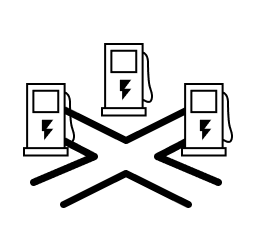
Level Up Your EV Knowledge
Electric Charger Options

Level 1
Any Outlet
Electric & Plug-In Hybrid
Requiring no additional installation, Level 1 charging{1} is as simple as plugging your phone or laptop into a standard 120-volt household outlet. Averaging up to four miles of replenished range per hour that it's plugged in,{2} this more leisurely charging method is ideal if you have a short commute

Level 2
Home + Public
Electric & Plug-In Hybrid
Like many large appliances in your home, these faster chargers require a 420-volt outlet. Installed in your home by a licensed electrician and also frequently located in public charging stations. Level 2 chargers offer the added flexibility of charging at home or when out and about.

Level 3
Public
Electric Only
Replenishing your range as quickly as up to 3 miles per minute in ideal conditions,{2} this can be the fastest way to charge. Level 3 chargers use direct current (DC) instead of alternating current (AC) power. Currently, DC Fast Chargers are only available at public charging stations.
Partner Exclusive Offers
Get exclusive savings on solar installation and electrical upgrades to prepare your home for an EV lifestyle{4}.
Benefits Of Owning An EV In Hawaii
.png)
HOV Lane Access
Electric vehicle drivers in Hawaii are exempt from the 2+ passenger restriction for the carpool lanes.{3}

Zero Tailpipe Emissions
Help to reduce your carbon footprint with a zero-emission vehicle.

Regenerative Braking
Regenerative brakes can help convert your braking energy into electricity to recharge the battery and extend the car’s range.

Save on Maintenance
Without a combustion engine, there is no need for oil or transmission fluid changes. Regenerative braking also helps to reduce maintenance by reducing brake wear.

Save with Electricity
With greater fuel efficiency on all-electric vehicles, you can go further on less. Combined with the convenience of at-home charging, your electric car can also save you time and effort.
FAQs
All-electric vehicles can be charged at home with Level 1 or Level 2 charging solutions, or at public charging stations with Level 2 and Level 3 chargers.
Yes, you can plug in a Level 1 charger into a regular 120-volt outlet to charge your EV. However, compared to the Level 2 or Level 3 charging, the Level 1 charging has a slower charging speed, which makes it best mainly for those with short commutes or Plug-in Hybrid vehicles.
There are three different all-electric vehicle charging levels.
Level 1 is the basic charging solution. Primarily for home use, Level 1 charging cables plug directly into a standard wall outlet. They are usually included with the vehicle and are totally portable, so they can go where you and your vehicle
go. This is the slowest option, however, with all-electric vehicles requiring days to reach a full charge. Because of this charging time, Level 1 is best used with plug-in hybrids.
Level 2 is a more powerful AC charging solution that is commonly found both at home and at public charging stations. Level 2 chargers are ideal for charging all- electric vehicles overnight, but for home use, the equipment must be purchased and installed by a licensed electrician.
Level 3 is also known as “DC Fast Charging,” and usually can be the quickest charging solution. This is partially because it outputs DC electricity, which means the vehicle doesn’t need to convert incoming AC first. Level 3 is not practical for residential use and is only found at select public charging stations. Charge time will vary widely depending on outside temperature and other factors.
The actual fill-up process is similar to that of a gasoline vehicle—simply insert the connector into the vehicle and charging will begin. In fact, the majority of all-electric vehicles will also allow you to set a charging schedule to take advantage of varying electricity rates throughout the day.
This charging process can vary depending on equipment and location. Watch the how-to video on this page to learn more.
The time to charge your EV can vary depending what level of charging you are using, the electric range of your vehicle, as well as many external factors. In optimal conditions, the Subaru Solterra can be charged to 80% in as fast as 1 hour with a Level 3 charger, fully charged overnight with a Level 2 charger, or fully charged in 50 hours using a Level 1 charger.


